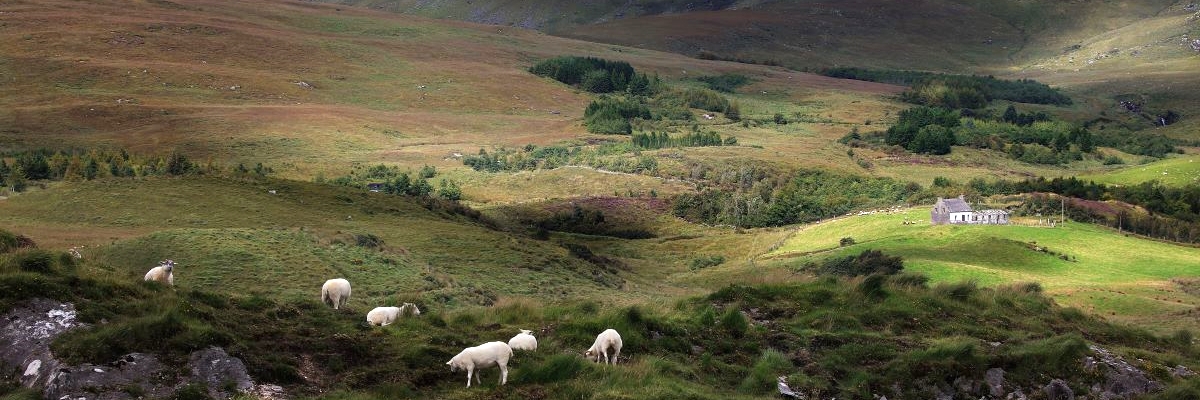Ring Of Kerry
The Ring of Kerry is a 110 mile drive that straddles the majestic coast of the largest of Kerry’s peninsulas, The Iveragh Peninsula.
We strongly recommend you travel anticlockwise, which is the direction the tour coaches take. Otherwise you will be manoeuvering against oncoming coaches on narrow roads all day long.
All the large vehicles leave Killarney, 30 miles ahead of you, before you even leave Kenmare so you will not be travelling behind a bus all the way as the guide books fear.
Depart Kenmare on the N71 towards Killarney.
The first point of interest is Molls Gap. It is the highest peak on the road with views of the Black Valley and MacGillycuddy Reeks, Ireland highest mountain range. Carrauntoohil, the highest peak reaches 1038 m.
Travel on to Ladies View and take time to absorb the views of the Lakes of Killarney. You are now in the National Park which covers 25,000 acres of the valley into Killarney and the surrounding mountains.
The Park incorporates many worthwhile places to visit such as Torc Waterfall where the Owengarriff River cascades through the wooded Friar’s Glen and into Muckross Lake.
Muckross House and Gardens are popular visitor attractions. A visit to the house is a good option on a rainy day.
Ross Castle – The castle was built on the shore of the lake in the late 15th century by the O’ Donoghue Ross chieftains.
Be careful however, as you have only travelled 20 miles of a 110 mile tour so do not spend all day in the Park area.
On entering Killarney keep left for the N70/Killorglin road.
Killorglin is an old market town. Today, it has several substantial businesses and is home to FEXCO, a very successful financial services company and one of the biggest employers in the area.
Glenbeigh is the next village and brings you back to the coast for the remainder of the drive. A pretty village where you can take some time and turn off for Rossbeigh, one of the finest beaches in Ireland.
Rossbeigh is a long Atlantic surf beach. You can walk along it’s sand dunes which extend several kilometers into the Atlantic. Lifeguards are on duty during the summer months. It is safe to bathe here at these times.
Kells Bay, Cahergal Forts and Doulus Head are the attractions between Glenbeigh and Caherciveen.
Cahersiveen is the largest town on the Ring of Kerry. It is a good place to stop for lunch or walk around the marina.
Alternatively, on leaving Caherciveen town, you can take a detour and take the ferry from Renard Point to Velentia Island. The ferry runs continuously in the summer months.
Be sure and visit Valentia Slate Quarry located just three kilometres north of Knightstown, the slate quarry was first opened in 1816 and run by different companies for almost 100 years until a rock fall closed the mine in 1911. The slate was used on the original floors at Westminster, laid back in the 19th century. Valentia slate has also been used in a number of other London Landmarks including Westminster Abbey, Westminster Cathedral and St Paul’s Cathedral as well as some of the capitals best known train stations at Waterloo, Charing Cross and Black Friars.
There is a majestic viewing point on top of the mountain in the centre of the island. You can walk to the west point of the island for views of the Atlantic from the Blasket Islands to Dursey and beyond.
It is also a great place to view the Skellig Islands. Skellig Michael is the larger of the two Skellig Islands. It is one of Ireland’s most important historical locations and is a UNESCO World Heritage Site. The island was a centre of monastic life for monks from the 7th century. The monastery is situated almost at the summit of the 230-metre-high rock. There are daily boat trips to the island in summer if the weather permits. Those, not wanting to brave the Atlantic swell ,can visit the Skellig Centre on Valentia just before leaving the island at Portmagee.
Another worthwhile detour is to visit the Cill Rialaig Project in Ballinskelligs. Some of the ruined cottages of the old village of Cill Rialaig have been restored as studio retreats for artists needing time and space away from their usual environment. It has become an artistic retreat of international repute. It has a small gift shop offering many artistic creations from the artists in residence. The retreat is set in an area of spectacular natural beauty.
Returning to the N70 head for Waterville, the holiday home of Charlie Chaplin. The next mountain pass is known as Coomakesta Pass with breathtaking views of Kenmare Bay and the Beara on the south side of the bay.
On entering Caherdaniel turn right for Derrynane House and Abbey. This was the home of Daniel O’Connell (1775-1847), the great parliamentarian and barrister who, using political advocacy and popular agitation, won civil rights for Irish Catholics in 1829. The house is open to the public and displays many artifacts of the time. The house is set on a magnificent set of beaches which when the tide is out offers a windswept walk across the sands.
Castlecove is the next town where you should take time to visit Staigue Fort. Staigue fort is an important monument from the Celtic era. It is one of the largest and finest ring forts in Ireland and is approximately 2000 years old.
The award winning village of Sneem is the last town before returning to Kenmare. Former French President Charles de Gaulle holidayed here on numerous occasions and there is a sculpture commemorating this in the village. The village of Sneem is a treasure trove of international sculpture, accessible to all, free of charge, throughout the year.
Get in Touch
Address
—




